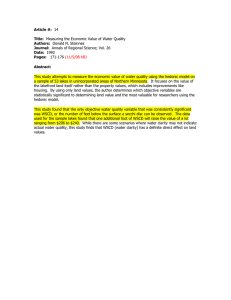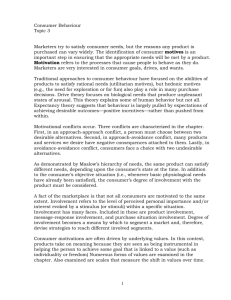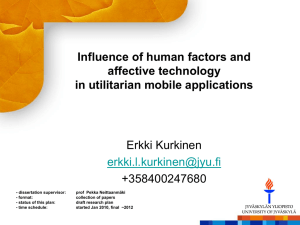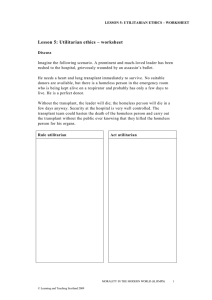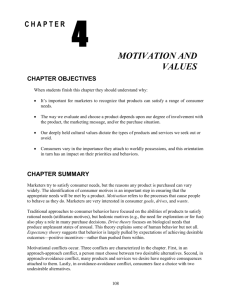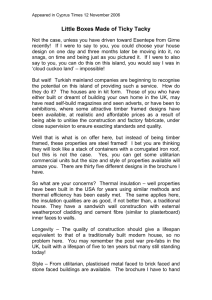Research Journal of Applied Sciences, Engineering and Technology 4(13): 1953-1961,... ISSN: 2040-7467
advertisement
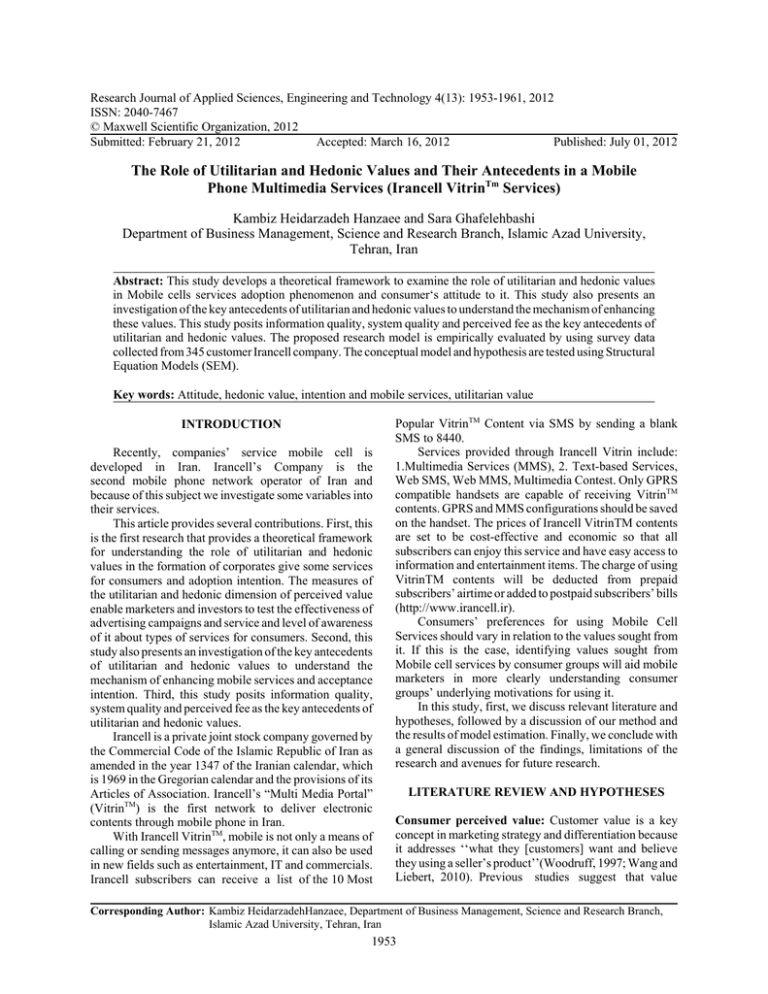
Research Journal of Applied Sciences, Engineering and Technology 4(13): 1953-1961, 2012 ISSN: 2040-7467 © Maxwell Scientific Organization, 2012 Submitted: February 21, 2012 Accepted: March 16, 2012 Published: July 01, 2012 The Role of Utilitarian and Hedonic Values and Their Antecedents in a Mobile Phone Multimedia Services (Irancell VitrinTm Services) Kambiz Heidarzadeh Hanzaee and Sara Ghafelehbashi Department of Business Management, Science and Research Branch, Islamic Azad University, Tehran, Iran Abstract: This study develops a theoretical framework to examine the role of utilitarian and hedonic values in Mobile cells services adoption phenomenon and consumer‘s attitude to it. This study also presents an investigation of the key antecedents of utilitarian and hedonic values to understand the mechanism of enhancing these values. This study posits information quality, system quality and perceived fee as the key antecedents of utilitarian and hedonic values. The proposed research model is empirically evaluated by using survey data collected from 345 customer Irancell company. The conceptual model and hypothesis are tested using Structural Equation Models (SEM). Key words: Attitude, hedonic value, intention and mobile services, utilitarian value INTRODUCTION Recently, companies’ service mobile cell is developed in Iran. Irancell’s Company is the second mobile phone network operator of Iran and because of this subject we investigate some variables into their services. This article provides several contributions. First, this is the first research that provides a theoretical framework for understanding the role of utilitarian and hedonic values in the formation of corporates give some services for consumers and adoption intention. The measures of the utilitarian and hedonic dimension of perceived value enable marketers and investors to test the effectiveness of advertising campaigns and service and level of awareness of it about types of services for consumers. Second, this study also presents an investigation of the key antecedents of utilitarian and hedonic values to understand the mechanism of enhancing mobile services and acceptance intention. Third, this study posits information quality, system quality and perceived fee as the key antecedents of utilitarian and hedonic values. Irancell is a private joint stock company governed by the Commercial Code of the Islamic Republic of Iran as amended in the year 1347 of the Iranian calendar, which is 1969 in the Gregorian calendar and the provisions of its Articles of Association. Irancell’s “Multi Media Portal” (VitrinTM) is the first network to deliver electronic contents through mobile phone in Iran. With Irancell VitrinTM, mobile is not only a means of calling or sending messages anymore, it can also be used in new fields such as entertainment, IT and commercials. Irancell subscribers can receive a list of the 10 Most Popular VitrinTM Content via SMS by sending a blank SMS to 8440. Services provided through Irancell Vitrin include: 1.Multimedia Services (MMS), 2. Text-based Services, Web SMS, Web MMS, Multimedia Contest. Only GPRS compatible handsets are capable of receiving VitrinTM contents. GPRS and MMS configurations should be saved on the handset. The prices of Irancell VitrinTM contents are set to be cost-effective and economic so that all subscribers can enjoy this service and have easy access to information and entertainment items. The charge of using VitrinTM contents will be deducted from prepaid subscribers’ airtime or added to postpaid subscribers’ bills (http://www.irancell.ir). Consumers’ preferences for using Mobile Cell Services should vary in relation to the values sought from it. If this is the case, identifying values sought from Mobile cell services by consumer groups will aid mobile marketers in more clearly understanding consumer groups’ underlying motivations for using it. In this study, first, we discuss relevant literature and hypotheses, followed by a discussion of our method and the results of model estimation. Finally, we conclude with a general discussion of the findings, limitations of the research and avenues for future research. LITERATURE REVIEW AND HYPOTHESES Consumer perceived value: Customer value is a key concept in marketing strategy and differentiation because it addresses ‘‘what they [customers] want and believe they using a seller’s product’’(Woodruff, 1997; Wang and Liebert, 2010). Previous studies suggest that value Corresponding Author: Kambiz HeidarzadehHanzaee, Department of Business Management, Science and Research Branch, Islamic Azad University, Tehran, Iran 1953 Res. J. Appl. Sci. Eng. Technol., 4(13): 1953-1961, 2012 perception comprises various components and should be viewed as a broad concept consisting of several dimensions (Smith and Colgate, 2007; Okazaki, 2008; Wang and Liebert, 2010) and conceptualized as two values (i.e., hedonic and utilitarian). Academics and practitioners therefore widely recognize that consumer perceived value is an important facilitating factor in consumer behavior. Researchers have found that consumer value is a primary motivation for using a certain service Consumer value is generally considered to be the relativistic preference characterizing a consumer experience for interacting with specific objects (i.e. any good, service, thing, place, event, or idea) (Parasuraman et al., 1985; Yang and Lee, 2010). Therefore, the concept of value is relativistic (i.e. personal) or context (i.e., situation) dependent (Kleijnen et al., 2007; Yang and Lee, 2010) and consumers’ motivations to use a service will differ in the way consumers perceive the value of the services (Hirshman and Holbrook, 1982; Yang and Lee, 2010). Hoffman and Novak (1996) stated that services could be categorized as goal-oriented utilitarian services and experiential hedonic services (Yang and Lee, 2010). The role of utilitarian and hedonic values: The concept of “value” has proved to be an enduring endeavor for a wide range of philosophers and researchers (Babin et al., 1994; Zeithaml, 1988). Researchers are continually seeking a more complete understanding of consumer value. An extensive literature review has established that perceived value has been conceptualized as what consumers get for what they give, or the consumer’s overall evaluation of the utility of a product or service provision based on perceptions of what one receives for what one gives (Baker et al., 1994; Zeithaml, 1988). Within this perspective, Zeithaml (1988) identified four common uses of the term: “low price”, “whatever I want in a product”, “the quality I get for the price I pay” and “what I get for what I give”. Hirshman and Holbrook (1982) described consumers as either “problem solver” or in terms of consumers seeking fun, fantasy, arousal sensory stimulation. This dichotomy has been represented in consumer behavior studies. Customer values classifications of utilitarian and hedonic values (Babin et al., 1994; Lageat et al., 2003; Ryu et al., 2010). Customers might have a different perception from “value” which is based on own personal values, needs, preferences and financial resources. Utilitarian value has actual and tangible attributes. Utilitarian value based on fulfilling a basic need and purchased and consumed for fulfilling consumers basic and functional needs. In selection and decision making for utilitarian product, consumers follow utility and function maximizing approach. Clearly, utilitarian and hedonic values are considered fundamental to understanding consumers’ evaluations of the consumption experience because they maintain a basic underlying presence across consumption phenomena (Ryu et al., 2010). Taken together, these two dimensions indicate an assessment of the overall worth of consumption activity, representing a more comprehensive picture of the value. Thus, in this study we adopted this two-dimensional conceptualization of consumer value: The first dimension is a utilitarian dimension resulting from work aspects and the second is a hedonic dimension derived from the fun perspective. Utilitarian value is closely related to the effectiveness and efficiency that result from the use of a service (Venkatesh and Brown, 2001; Kim and Han, 2011). Consumers’ utilitarian value for a service will be driven by a sense of accomplishment through the use of services (Jones et al., 2006; wang and Liebert, 2010). Owing to the ubiquitous characteristics of mobile data services, consumers’ utilitarian value sought from mobile data services will differ from traditional service encounters. Kleijnen et al. (2007) found that flexibility of use, convenience of time and place and personalization enhance consumers’ utilitarian value of mobile data services uses. These services drive usage intentions because they relate directly to the consumer’s goals of information acquisition and completing the transactions through mobile services (Kleijnen et al., 2007; Yang and Lee, 2010). From a utilitarian value perspective, the use of the service is understood as a means of accomplishing some task-related end (Babin et al., 1994). Most studies on the IS domain have strongly supported utilitarian value as a crucial determinant of prompting behavioral intention to adopt and use IS because customers make rational, calculated assessments of the functional benefits and sacrifices of using IS (Hong and Tam 2006; Kim et al., 2007; Han and Kim, 2011). On the other hand, hedonic value is primarily non-instrumental, experiential and affective (Kim and Han, 2009, 2011). Customers experience hedonic value when the activity of using IS is appreciated in its own right aside from its instrumental value. Compared to the utilitarian aspects of IS, hedonic value is more subjective and personal than utilitarian value and results from the fun derived rather than task completion (Hirshman and Holbrook, 1982). Research on IS has empirically shown that hedonic value is also a key determinant that consumers perceive as important in the context of IS use (Kim and Han, 2011). Hoffman and Novak (1996) stated that services could be categorized as goal-oriented utilitarian services and experiential hedonic services. Various mobile data services can be further categorized as utilitarian and hedonic value and its value perceptions can be judged as a driving value of using mobile data services. Consumer value derived from using a certain service can often be 1954 Res. J. Appl. Sci. Eng. Technol., 4(13): 1953-1961, 2012 Information quality dimensions Accuracy Completenes Currency Format System quality dimensions Accessibility Navigation Reliability Timeliness Information quality Perceived fee Utilitarian value Perceived usefulness Attitude Adaption intention Perceived ease of use Hedonic value System quality Fig. 1: Conceptual model distinguished as hedonic or utilitarian value. In other words, individual consumers’ service usages will differ to the extent in which their behaviors are derived from hedonic or utilitarian values (Batra and Ahtola, 1990; Kim and Han, 2011). Hedonic value is more subjective and personal than utilitarian value. It is the experiential and emotional motivations of consumer behavior that can be derived from the multisensory, emotive and entertainment aspect of experience in the consumption process (Babin et al., 1994; Hirshman and Holbrook, 1982). In a mobile service context, hedonic value may be derived from the immediate pleasure or joy of communicating with other people on a mobile phone or interacting with mobile phone technology. Furthermore, consumers who seek hedonic value in using mobile data services will be likely to respond to entertainment aspects of mobile data services (e.g. mobile game, downloading ringtones) and to emotional aspects of service features such as emoticons in text messaging or avatars. In this conceptual model has 14 Hypotheses that include: H1: H2: H3: H4: H5: H6: H7: H8: H9: H10: Antecedents of utilitarian and hedonic values: Monroe (1990) stated that perceived value is the trade-off between perceived quality and perceived fee. Perceived fee is defined as the customer’s perception of the fee sacrificed to acquire a service (Kim et al., 2007, 2009; Voss et al., 1998; Kim and Han, 2011). In an organizational setting, the costs of adoption and usage of IS would not be a big issue for users since the cost is borne by the organization. Previous literature on Mobile services and marketing. This study is primarily focused on the Mobile services and services quality as the ‘get’ components and perceived fee as the ‘give’ component. The proposed model focuses on the relationships between Utilitarian and Hedonic value, Information and system Quality Dimensions, Adaption intention and perceived ease of use, perceived usefulness and attitude. The research model is presented in Fig. 1. H11: H12: H13: H14: Utilitarian value has a positive impact on adoption intention. Hedonic value has a positive impact on adoption intention. Information quality has a positive impact on utilitarian value. Information quality has a positive impact on hedonic value. System quality has a positive impact on utilitarian value. System quality has a positive impact on hedonic value. Perceived fee has a negative impact on utilitarian value. Perceived fee has a negative impact on hedonic value. Utilitarian value has a positive impact on perceived usefulness. Hedonic value has a positive impact on attitude toward using Irancell VitrinTM services. Perceived ease of use has a positive impact on perceived usefulness of Irancell VitrinTM services. Perceived ease of use has a positive impact on attitude toward using Irancell VitrinTM services. perceived usefulness has a positive impact on attitude toward mobile Irancell VitrinTM services. Attitude about mobile Irancell VitrinTM services has a positive impact on adaptation intention. MATERIALS AND METHODS Data collections and sample: The data for this study were collected in Iran by means of a national selfadministered consumer questionnaire survey. This sample was conducted in January 2011. The case studies are students at Islamic Azad University of city of Tehran that use Irancell vitrinTM services. The demographic profile of 1955 Res. J. Appl. Sci. Eng. Technol., 4(13): 1953-1961, 2012 respondents (Table 1) revealed that the proportion of males and females was approximately even, with slightly more males in the sample. Most respondents were relatively young, with the majority being between 25 and 30 years old. A large majority of respondents (82.3%) were single, whereas a total of approximately 17.7% were couples. most of the respondents had annual household incomes less than 800,000 Tomans (58.1 %) and 12.2% had the annual income more than 2,000,000 Tomans. Measures : Table 2 displays the questions used in this study. Respondents were asked to rate 51 items using a seven-point Likert type scale (extremely disagree; extremely agree). These questions designed by previous studies (Yang and Lee, 2010; Kim and Han, 2011). Data analysis : LISREL, Structural Equation Modeling (SEM) software, was used to analyze the survey data. Table 1: Demographic Profile of Respondents Item frequency Gender Male 185 Female 160 Marital status Single 284 Married 97 Age 18-24 98 25-30 182 31-40 30 Over 40 35 Education level Diploma- Associates Degree 125 Bachelor 131 Master and higher 89 Monthly income (NT Tomans) <400,000 99 400,000-800,000 102 800,000-1,200,000 57 1,200,000-2,000,000 45 >2,000,000 42 Percentage 53.6 46.4 82.3 17.7 28.4 52.8 8.7 10.1 36.3 37.9 25.8 28.6 29.5 16.5 13.2 12.2 Table 2: Descriptive information for questions used in the study Variable Measurement Adoption intention I intend to use Irancell vitrin service in the future. I expect that I would use Irancell vitrin service in the future. I plan to use Irancell vitrin service in the future. Utilitarian value: Compared to the fee I need to pay, the use of Irancell vitrin service would offer a good value for the money Compared to the effort I need to put in, the use of Irancell vitrin service would be beneficial to me. Compared to the time I need to spend, the use of Irancell vitrin service would be worthwhile to me Overall, the use of Irancell vitrin service would deliver me good value. Hedonic value Irancell vitrin services would be ones that enjoy Irancell vitrin services would make me want to use them. Irancell vitrin services would be ones that I feel relaxed about using. Irancell vitrin services would make me feel good. Perceived fee The fee that I have to pay for the use of Irancell vitrin services would be too high. The fee that I have to pay for the use of Irancell vitrin services would be reasonable (reversed). I would be pleased with the fee that I have to pay for the use of Irancell vitrin services (reversed). Overall, I would give the information from Irancell vitrin services high marks. Overall, I would give the information provided by Irancell vitrin services a high rating in terms of quality. In general, Irancell vitrin services would provide me with highquality information. System quality In terms of system quality, I would rate Irancell vitrin services highly. Overall, Irancell vitrin services would be of high quality. Overall, I would give the quality of Irancell vitrin services a high rating. Accuracy Irancell vitrin services would produce correct services, so, information about services are correct. There would be fee errors in the information I obtain from Irancell vitrin services. So, services and information would be errors. The information provided by Irancell vitrin services would be accurate. Completeness By Irancell vitrin services would provide me with a complete set of information about mobile service. Irancell vitrin services would produce comprehensive information about mobile service. Irancell vitrin services would provide me with all the information when I need mobile services. Currency Irancell vitrin services would provide me with the most recent information about mobile services. Irancell vitrin services would produce the most current information about mobile services. The services from Irancell vitrin services would be always up to date. Format The services provided by Irancell vitrin services would be well formatted. The services provided by Irancell vitrin services would be well laid out. The services provided by Irancell vitrin services would be clearly presented on the screen 1956 Res. J. Appl. Sci. Eng. Technol., 4(13): 1953-1961, 2012 Table 2: (continued) Variable Accessibility Measurement Irancell vitrin services would allow services to be readily accessible to me. Irancell vitrin services would make services very accessible. Irancell vitrin services would make services easy to access. Navigation Irancell would be easy to recognize where the services I need. Irancell would be easy to find services I want. I would be able to be aware of the services that Irancell has. Reliability Irancell vitrin services would operate reliably. Irancell vitrin services would perform reliably The operation of Irancell vitrin services would be dependable. Timeliness It would take too long for Irancell vitrin services to respond to my requests. Irancell vitrin services would provide services in a timely fashion Irancell vitrin services would return answers to my requests quickly. Usefulness Perceived Using irancell vitrin services improves my efficiency usefulness Using irancell vitrin services makes me save time Perceived Perceived ease of use Learning to use irancell vitrin services is easy for me My interaction with irancell vitrin services is clear and understandable It is easy to make irancell vitrin services do what I want them to It is easy to use irancell vitrin services Attitude Using irancell vitrin services is a good idea I am favorable about using irancell vitrin services Using irancell vitrin services is a wise idea I am positive about irancell vitrin services SEM is a very general, largely linear, typically crosssectional statistical modeling technique. A LISREL model begins with a specification of a causal relationship between unobservable constructs represented by latent variables, which are empirical measures of the constructs. Each latent variable is measured by one or more observable indicator variables. These indicator variables are assumed to be measured with error. The two-step approach of SEM refers to a process in which the measurement model is first estimated and then, it is fixed in the second stage when the structural model is estimated (Hair et al., 1998). Following this recommendation this study performs two stage approach, analyzing measurement model and structural model respectively. RESULTS Measurement model: Researchers have reached a consensus that validity is the most important concept in measurement. The measurement scale was first tested for reliability and validity following which; the path model was assessed A Confirmatory Factor Analysis (CFA) was conducted (Agarwal and Prasad, 1998; Table 2) using the LISREL 8.8. The goodness-of-fit indices for the model indicated strong fit, with P2 = 1348.08 (p < 0.001), with 492 degrees of freedom, a normed-P2 of 2.74, a Goodness-of-Fit Index (GFI) of 0.90, an Adjusted Goodness-of-Fit Index (AGFI) of 0.88, a Normalized-Fit Index (NFI) of 0.92, an Incremental Fit Index (IFI) of 0.94, a Tucker–Lewis Index (TLI) of 0.93 and a Root Mean Square Error of Approximation(RMSEA) of 0.056. All the fit indicators were above the common acceptance levels suggested by the literature (Bollen, 1989; Jöreskog and Sörbom, 1993). The examination of convergent validity requires scrutiny of factor loadings and Squared Multiple Correlations (SMCs) of the measurement items (Bollen, 1989). All factor loadings had values between 0.771 and 0.901 on their underlying constructs and were significant (p <0.01). In addition, the SMCs were calculated for all items (Table 2). All items had SMC values greater than the suggested value of 0.4 (Bollen, 1989). According to Fornell and Larcker (1981), discriminant validity is established if, for any two constructs, A and B, the Average Variance Extracted (AVE) for A and the AVE for B exceed the squared correlation between A and B. The inter-construct correlations were calculated based on the averaged scales for these constructs, that is, items pertaining to each underlying construct were averaged. In this case, all AVE scores were greater than the suggested cut-off value of 0.5 (Fornell and Larcker, 1981). Furthermore, the AVE scores for any two constructs were greater than their corresponding squared interconstruct correlations (Table 3). Using SEM for hypotheses testing. In this study, to test the validity of measurement used, Confirmatory Factor Analysis (CFA) was employed to assess, develop and modify the proposed theoretical model. Here, a series 1957 Res. J. Appl. Sci. Eng. Technol., 4(13): 1953-1961, 2012 Table 3: Results of average variance extracted and squared correlations of each construct Constructs 1 2 3 4 5 Information Quality (1) 0.74 System Quality (2) 0.12 0.69 Perceived Fee (3) 0.19 0.20 0.67 Utilitarian Value (4) 0.28 0.09 0.17 0.65 Usefulness perceived (5) 0.18 0.12 0.03 0.29 0.71 Perceived ease of use (6) 0.23 0.19 0.07 0.18 0.32 Hedonic Value (7) 0.32 0.08 0.01 0.23 0.37 Attitude (8) 0.28 0.12 0.19 0.32 0.16 Adaption Intention (9) 0.17 0.16 0.16 0.28 0.31 Table 4: Confirmatory Factor Analysis Constructs and Items Item loadings Information Quality Accuracy 0.887 Completeness 0.834 Currency 0.810 Format 0.889 System Quality 0.859 Accessibility 0.791 Navigation 0.895 Reliability 0.822 Timeliness 0.819 Perceived Fee Q12 0.840 Q13 0.841 Q14 0.810 Q15 0.799 Q16 0.862 Q17 0.781 Utilitarian Value Q4 0.808 Q5 0.849 Q6 0.887 Q7 0.871 Usefulness perceived Q45 0.890 Q46 0.828 Perceived ease of use Q47 0.884 Q48 0.839 Q49 0.824 Q50 0.819 Hedonic Value Q8 0.901 Q9 0.817 Q10 0.884 Q11 0.832 Attitude Q51 0.871 Q52 0.850 Q53 0.827 Q54 0.856 Adaption Intention Q1 0.771 Q2 0.819 Q3 0.814 Squared MultipleCorrelations 6 7 8 9 0.79 0.39 0.08 0.11 0.74 0.25 0.31 0.71 0.19 0.69 Cronbach’s " 0.905 Composite Construct Reliabilities 0.916 0.812 0.926 0.799 0.915 0.819 0.849 0.844 0.906 0.873 0.918 0.838 0.913 0.772 0.843 0.787 0.696 0.656 0.790 0.900 0.626 0.801 0.676 0.671 0.706 0.707 0.656 0.638 0.743 0.610 0.653 0.721 0.787 0.759 0.792 0.686 0.781 0.704 0.679 0.671 0.812 0.667 0.781 0.692 0.759 0.723 0.684 0.733 0.594 0.671 0.663 of confirmatory factor analysis that utilized maximum likelihood estimation to test measurement model were carried out for each of nine latent variables (Information Quality, System Quality, Perceived Fee, Utilitarian Value, Usefulness perceived, Perceived ease of use, Hedonic Value, Attitude, Adaption Intention). In order to reach acceptable model fit, the measurement was tested for unidimensionality, reliability and validity.To examine the reliabilities of the scales, Cronbach’s alpha values were calculated (Table 4). The alpha values for all scales ranged between 0.772 and 0.905, thus exceeding the suggested cut-off point of .7 (Hair et al., 1998; Nunnally, 1978). Thus, it was concluded that the constructs had satisfactory reliability and were kept for further analyses. 1958 Res. J. Appl. Sci. Eng. Technol., 4(13): 1953-1961, 2012 Utilitarian value 0.22* Information quality 0.35** 0.05 -0.27** 0.28** Perceived usefulness 0.22* Perceived fee Attitude ** 0.41 0.08 System quality -0.02 Perceived ease of use ** 0.35 Adaption intention 0.08 0.30** ** 0.30 0.10 * p-value < 0.05 < 0.01 **p-value Hedonic value Fig. 2: Model Testing Results Table 5: The results of hypothesis testing Hypothesized Path Hypothesis 1: Utilitarian value ÷ adoption intention Hypothesis 2: Hedonic value ÷adoption intention Hypothesis 3: Information quality ÷Utilitarian value Hypothesis 4: Information quality ÷Hedonic value Hypothesis 5: System quality ÷Utilitarian value Hypothesis 6: System quality ÷Hedonic value Hypothesis 7: Perceived fee ÷Utilitarian value Hypothesis 8: Perceived fee ÷Hedonic value Hypothesis 9: Utilitarian value ÷perceived usefulness Hypothesis 10: Hedonic value ÷ attitude Hypothesis 11: Perceived ease of use ÷perceived usefulness Hypothesis 12: Perceived ease of use ÷attitude Hypothesis 13: perceived usefulness ÷attitude Hypothesis 14: attitude ÷adoption intention Path coefficient 0.35 0.30 0.22 0.28 0.08 0.10 - 0.27 - 0.02 0.05 0.30 0.41 0.08 0.22 0.43 In addition, the Composite Construct Reliabilities (CCRs) were calculated for all constructs (Table 2). The composite reliability is a measure that depicts the extent to which a number of items indicate a common construct (Hair et al., 1998). In this study, all CCR values were greater than the acceptable level of 0.7 (Hair et al., 1998). Therefore, the conditions for convergent and discriminant validity were met for all constructs. CONCLUSION The research model was analyzed using Structural Equation Modeling (SEM), using the LISREL 8.8. Fitting the model to the sample resulted in a chi-square value of 1397.20 (p<0.001), with 499 degrees of freedom and a normed-P2 of 2.80. Furthermore, the model had a GFI value of 0.90, an AGFI value of 0.89, a NFI value of 0.93, an IFI value of 0.94, a TLI value of 0.94 and a RMSEA value of 0.061. All the fit measures exceeded their suggested values (Jöreskog and Sörbom, 1993) and thus, it was concluded that the model fit was good. Significance of the path loadings provided results for hypothesis testing (Fig. 2). Among the model’s 14 hypotheses, nine hypotheses are supported including (H1, H2, H3, H4, H7, H10, H11, H13 and H14), five p-value p>0.01 p>0.01 p>0.05 p>0.01 n.s. n.s. p>0.01 ns. n.s. p>0.01 p>0.01 n.s. p>0.05 p>0.01 Conclusion Supported Supported Supported Supported Not Supported Not Supported Supported Not Supported Not Supported Supported Supported Not Supported Supported Supported hypotheses were not supported (namely H5, H6, H8, H9 and H12). H1 and H2 are concerned with the effects of Utilitarian value and Hedonic value on adoption intention. With path coefficients of 0.35 (t = 3.83) and 0.30 (t = 3.32) it can be said that both hypothesis are supported by the data. H3 and H4 are about the impact of Information quality on Utilitarian value and Hedonic value; as it can be seen in Table 5, since the corresponding routs are statistically significant, H3 and H4 are also confirmed. But H5 and H6 are not supported by data with non significant t-values of 0.26 and 0.31. H7 and H8 concern the impact of Perceived fee on Utilitarian value and Hedonic value. Also H7 is supported by the data (t = 2.93) but H8 is not confirmed (-0.12). H9 is also not supported by the data because the path from Utilitarian value to perceived usefulness is not significant at 0.05 levels. Since the route from Hedonic value to attitude is significant (t = 3.32), H10 is confirmed. Although Perceived ease of use have a significant impact on perceived usefulness (t = 4.09) but the path from Perceived ease of use to attitude is not significant (0.12); so H11 is confirmed but H12 is rejected. H13 concerning the effect of perceived usefulness on attitude is also supported with path coefficient of 0.22 and t-value of 1959 Res. J. Appl. Sci. Eng. Technol., 4(13): 1953-1961, 2012 1.83. Finally, H14 is also supported by the findings with significant path coefficient of 0.43 between attitude and adoption intention. Finding: The research framework asserts that adoption intention is determined by utilitarian and hedonic values of Mobile phone Multimedia Services and these are determined by the perceptions of cost, information quality and system quality of it. So, this study attempts to understand the role of utilitarian and hedonic values and their antecedents in the Mobile phone Multimedia Services. Marketers should emphasize the benefits of Mobile phone Multimedia Services in terms of usability and functional utility which will enhance task performance. for example using a Video clips, games and special mobile software as well as ring tones, wallpapers, themes and other mobile related contents or This service to send SMS to other Irancell subscribers or all other mobile phone users in Iran or around the world via Internet, without any need to use their mobile phones. This study investigates that utilitarian and hedonic values are a function of information quality. Utilitarian and hedonic values aren’t a function of information quality. Perceived fee has the strongest effect on utilitarian value, implying that the cost of adopting Mobile phone Multimedia Services is the most important determinant of forming and judging utilitarian value. But, hedonic value is largely explained by information quality, implying that perceived fee is a relatively less important factor in customers’ emotional evaluation of it. Consumer’s attitudes toward using Mobile phone Multimedia Services would be positive in social networking activities. Furthermore, hedonic value that is derived from entertainment and experiential functions and features of it will drive consumers to use the services. The effect of perceived ease of use on perceived usefulness was significant for consumers. Consumers tend to explore the newest functions of Mobile phone Multimedia Services and learning to use Mobile phone Multimedia Services may not be burden to them. This study indicating that the level of ease of use Mobile phone Multimedia Services is not significant variable influencing consumers’ attitudes toward using Mobile phone Multimedia Services for consumers. This would be because consumers become tech savvy, thus, the level of easiness to use the technology-based services is not a significant determinant to predict consumer intention to use the services. REFERENCES Agarwal, R. and J. Prasad, 1998. A conceptual and operational definition of personal innovativeness in the domain of information technology. Inf. Syst. Res., 9: 204-215. Babin, B.J., W.R. Darden and M. Griffin, 1994. Work and/or fun: Measuring hedonic and utilitarian shopping value. J. Consum. Res., 20: 644-656. Baker, J., D. Grewal and A. Parasuraman, 1994. The influence of the store environment on quality inferences and store image. J. Acad. Market. Sci., 22: 328-339. Batra, R. and O. Ahtola, 1990. Measuring the hedonic and utilitarian sources of consumers attitudes. Market. Lett., 2(2): 159-170. Bollen, K.A., 1989. Structural Equations with Latent Variables. Wiley, New York. Fornell, C. and D. Larcker, 1981. Structural equation models with unobservable variables and measurement error. J. Market. Res., 18: 39-50. Hair, J.F., R.E. Anderson, R.L. Tatham and W.C. Black, 1998. Multivariate Data Analysis with Readings. 5th Edn., Prentice Hall, New York. Hirshman, E.C. and M.B. Holbrook, 1982. Hedonic consumption: Emerging concepts. J. Marketing, 46(3): 92-101. Hong, S.J. and K.Y. Tam, 2006. Understanding the adoption of multipurpose information appliances: The case of mobile data services. Inf. Syst. Res., 17(2): 162-179. Hoffman, D.L. and T.P. Novak, 1996. Marketing in hypermedia computer-mediated environments: Conceptual foundations. J. Marketing, 60: 50-68. Jöreskog, K.G. and D. Sörbom, 1993. LISREL 8 User’s Reference Guide. Scientific Software International, Chicago, IL. Jones, M.A., K.E. Reynolds and M.J. Arnold, 2006. Hedonic and utilitarian shopping value: Investigating differential effects on retail outcomes. J. Bus. Res., 5: 974-981. Kleijnen, M., K. De Ruyter and M. Wetzels, 2007. An assessment of value creation in mobile service delivery and the moderating role of time consciousness. J. Retailing, 83(1): 33-46. Kim, H.W., H.C. Chan and S. Gupta, 2007. Value-based adoption of mobile internet: An empirical investigation. Decis. Support Syst., 43(1): 111-126. Kim, B. and I. Han, 2009. What drives the adoption of mobile data services? An approach from a value perspective. J. Inf. Technol., 24(1): 35-45. Kim, K. and I. Han, 2011. The role of utilitarian and hedonic values and their antecedents in a mobile data service environment. Expert Syst. Appl., 38: 2311-2318. Lageat, T., S. Czellar and G. Laurent, 2003. Engineering hedonic attributes to generate perceptions of luxury: Consumer perception of an everyday sound. Market. Lett., 14(2): 97-109. Okazaki, S., 2008. Exploring experiential value in online mobile gaming adoption. Cyber Psychol. Behav., 11: 619-622. 1960 Res. J. Appl. Sci. Eng. Technol., 4(13): 1953-1961, 2012 Monroe, K.B., 1990. Pricing: Making Profitable Decisions. 2nd Edn., McGraw-Hill, New York. Nunnally, J.C., 1978. Psychometric Theory. 2nd Edn., McGraw-Hill, New York. Smith, J.B. and M. Colgate, 2007. Customer value creation: A practical framework. J. Market. Theor. Pract., 15: 7-23. Ryu, K., et al., 2010. Relationships among hedonic and utilitarian values, satisfaction and behavioral intentions in the fast-casual restaurant industry. Int. J. Contemporary Hospitality Manage., 22(3): 416-432. Parasuraman, A.V., A. Zeithaml and L.L. Berry, 1985. A conceptual model of service quality and its implications for future research. J. Marketing, 49(4): 41-50. Venkatesh, V. and S.A. Brown, 2001. A longitudinal investigation of personal computers in homes: Adoption determinants and emerging challenges. MIS Quart., 25(1): 71-102. Voss, G.B., A. Parasuraman and D. Grewal, 1998. The roles of price, performance and expectations in determining satisfaction in service exchanges. J. Marketing, 62(4): 46-61. Woodruff, R.B., 1997. Customer value: The next source for competitive advantage. J. Acad. Market. Sci., 25: 139-153. Wang, E. and M.A. Liebert, 2010. Internet usage purposes and gender differences in the effects of perceived utilitarian and hedonic value. J. Cyber psychol. Behav. Soc. Network., 13(2): 179-183. Yang, K. and H. Lee, 2010. Gender differences in using mobile data services: Utilitarian and hedonic value approaches. J. Res. Interact. Market., 4(2): 142-156. Zeithaml, V.A., 1988. Consumer perceptions of price, quality and value: A means-end model and synthesis of evidence. J. Marketing, 52: 2-22. 1961
